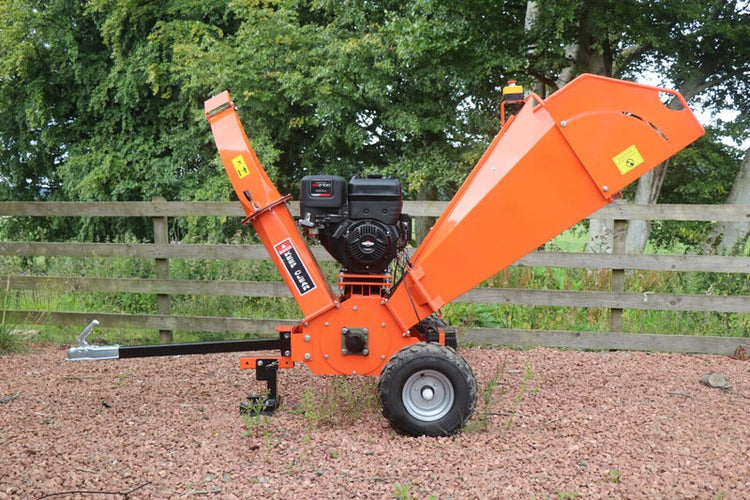If your work or place of residence requires you to get involved with woodland management of any scale, then having the right machinery to hand is essential for making the process as convenient, efficient and successful as possible.
But what equipment might this entail? Here at Rock Machinery, we’re experts in this field, supplying all of the equipment you may need. That’s why we’ve put together this comprehensive guide, detailing all of the essential woodland management equipment that you could benefit from - covering what each piece of equipment is intended for and how it works.
What is Woodland Management?
Woodland management refers to the planned activities that are carried out to woodland areas in order promote the health and steadiness of their growth or any other combination of benefits to the area. This could involve removing dead or rotting trees, coppicing trees that have their wood harvested, pollarding or even planting new trees to further establish the woodland.
By pruning and training trees in the correct way, it helps to keep them strong and healthy, ensuring they continue to thrive. This is especially important if you require their wood to be harvested, which should always be done in the most sustainable way possible with minimal impact to local habitats and wildlife.
Maintaining woodland areas can be a laborious and constant task, requiring patience and consistency. By putting in the effort to look after your trees, you will reap the benefits and avoid further unnecessary tasks later down the line that are otherwise unforeseen.
Who Does Tree Management Apply to?
Anyone can partake in tree management if they have certain trees on their property that require tending to. Of course, organisations and charities such as environmental trusts and local councils must also consider the importance and practise of proper tree management.
However, one sector that is often overlooked when people think about tree and woodland management is the timber industry. With the prevalence of sustainability in the modern socio-climate, sustainable timber practices are becoming even more important, which requires timber to be responsibly harvested from well-managed woodlands and forests - ensuring these are continuously replenished.
The equipment and machinery we offer here at Rock Machinery, then, is especially beneficial to those involved in the timber industry, whether on a large or small scale. Not only do we offer products that will help with the responsible management of your involved woodland areas, but our products can also help with subsequent timber-related tasks, such as wood splitting and chipping.
View our list below to learn about some of the key product types that we offer and how they can benefit you and your business.
From Petrol Wood Splitters to Compact Wood Chippers: A to Z of Equipment
(ATV) Backhoes
A backhoe, also referred to as a rear actor, is a type of excavation equipment that features a digging bucket at the end of a two-part articulated arm and is typically mounted on the back of a tractor, however a smaller type of backhoe, known as an ATV backhoe allows it to be used without being mounted on a tractor or similar vehicle.
ATV refers to all terrain vehicles, making ATV backhoes an incredibly versatile and useful compact solution for meeting excavation needs on hilly, uneven and/or grassy terrain - such as that often found at woodlands areas. Backhoes tend to be smaller and lighter in weight than excavators, which is what makes them so favourable for a range of tasks - particularly those that are more limited on space.
Uses
Backhoes can be used for a variety of tasks, especially since they can come with a variety of attachments. When it comes to the standard bucket attachment, they are especially great for various digging tasks, such as creating trenches that can be used for irrigation systems. They can also be used to dig holes to plant new trees, or may even be used to help remove dead tree stumps.
Safety Guidance
Many backhoes feature built-in safety features that are designed to protect both you as the operator and any surrounding workers on your site, however there is still some guidance you should follow to further ensure safety of both personnel and of the backhoe itself.
Due to the open nature of ATV backhoes, it’s recommended that you always wear long sleeves, trousers, over-the-ankle boots, gloves and goggles when operating one. These are classified as off-road vehicles, so you should avoid riding one on paved roads, except to cross for access and when you are legally permitted to do so.
Chippers
As their name suggests, a woodchipper is a machine that is used to reduce pieces of wood into smaller particles, known as chips. There are a wide range of chippers available, with most of these being portable. For example, you can get both towable and self-propelled varieties, along with compact models - each of which are capable of managing different quantities of wood depending on your requirements and desired outcome.
They work by feeding pieces of wood through a chute that has rotating blades inside to cut the wood that is fed into it, ejecting the chips from the machine through a separate opening.
Uses
Wood chippers are used to make different sized chips for a range of uses. For example, chips can be used to create mulch, which is great for nurturing and protecting plants in wintery conditions - without the need to use fertilisers or other chemical products.
Smaller chips can also be used for compost, being a carbon rich ingredient that’s great to mix in with green materials. As for larger chips, these can be used as starter-kindling for those who own log-burners.
Safety Guidance
When it comes to using wood chippers, one of the most important pieces of safety guidance is to feed branches in butt-end first and to let go when they have been gripped by the internal rollers - you should never be putting your hand into the chute, even slightly.
It’s also best to wear protective goggles and ear defenders for protection when operating a chipper.
Portable Saw Mills
With the ability to be transported using a towing vehicle, portable saw mills allow larger pieces of lumber to be split into more manageable sized logs, which is especially useful when doing so in the area where wood is being gathered and processed.
Because of their ability to be used on-site, they can even work out as having less impact on the environment, since you won’t need to clear as much space to allow for large vehicles to get through your woodland in order to transport larger pieces of lumber back out of it.
Uses
Portable saw mills are predominantly used to cut larger logs into a range of sizes and shapes used in timber production, such as timber beams or planks.
Safety Guidance
When it comes to using portable saw mills, it’s important to protect your eyes, ears and lungs. Chips and splinters of wood can fly up and hit you, hence why goggles should be worn. Sawdust and other dust particles are also produced, many of which are microscopic and can be breathed in - getting into your lungs - hence why a mask should also be worn.
As for protecting your ears, ear defenders are recommended to block out the noise of the machinery when working in such close proximity to it.
Splitters
Log splitters are rather self-explanatory - they’re used to split logs in half. They are a machine alternative to chopping logs manually using an axe, offering much more efficiency and consistency in doing so.
Splitter machines tend to be powered by either petrol or electricity, whilst hydraulic power is also utilised to physically split the logs. Many also feature anti-vibration legs and a kill switch for additional safety.
Uses
This is why logs are often split in order to be used for kindling.
Fire requires fuel, oxygen and heat to thrive; when used for burning, split wood offers an efficient balance of all three, thus making them easier to ignite than whole logs are. Furthermore, because they possess a larger surface area to volume ratio than whole logs, they continue to burn much more efficiently, as more surface is exposed to the air.
Whilst log splitters are predominantly used for preparing firewood, they can be used to split logs into smaller pieces for a range of different uses. The process also helps logs to dry out quicker.
Safety Guidance
As with most machinery, the necessary PPE should be worn when using a log splitter. It’s also important to avoid wearing certain items, such as loose clothing or long jewellery that could get caught in moving parts of the machine.
You should also never attempt to load the splitter whilst the wedge is actively in motion - always wait for it to finish splitting one log and stop its movement before loading the next one.
Additional Equipment
On top of the equipment we’ve already discussed, there is a range of additional equipment that may be of use to you, including:
- Sprayers
- Stump grinders
- Tree loppers
- Earth augers
- Firewood processors
- Towable spreaders
- Saw benches
We offer each of these here at Rock Machinery, so don’t hesitate to check out the entirety of our extensive product range!
Get in Touch
If you’ve seen a piece of equipment that would greatly benefit you and/or your business, then you can count on us to supply you with the equipment to suit your needs - all at competitive price.
Browse our product catalogue today, or get in touch to discuss your requirements with one of our helpful experts. We also offer free delivery across mainland UK!

